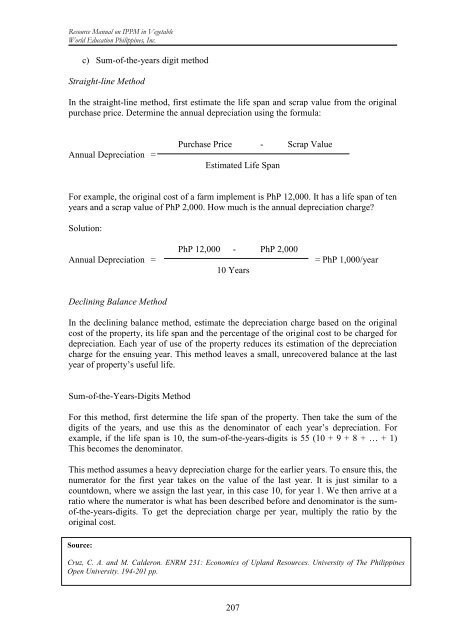Resource Manual on Integrated Production and Pest ... - julitoaligaen
Resource Manual on Integrated Production and Pest ... - julitoaligaen
Resource Manual on Integrated Production and Pest ... - julitoaligaen
Create successful ePaper yourself
Turn your PDF publications into a flip-book with our unique Google optimized e-Paper software.
<str<strong>on</strong>g>Resource</str<strong>on</strong>g> <str<strong>on</strong>g>Manual</str<strong>on</strong>g> <strong>on</strong> IPPM in Vegetable<br />
World Educati<strong>on</strong> Philippines, Inc.<br />
c) Sum-of-the-years digit method<br />
Straight-line Method<br />
In the straight-line method, first estimate the life span <strong>and</strong> scrap value from the original<br />
purchase price. Determine the annual depreciati<strong>on</strong> using the formula:<br />
Annual Depreciati<strong>on</strong> =<br />
Purchase Price - Scrap Value<br />
Estimated Life Span<br />
For example, the original cost of a farm implement is PhP 12,000. It has a life span of ten<br />
years <strong>and</strong> a scrap value of PhP 2,000. How much is the annual depreciati<strong>on</strong> charge?<br />
Soluti<strong>on</strong>:<br />
PhP 12,000 - PhP 2,000<br />
Annual Depreciati<strong>on</strong> = = PhP 1,000/year<br />
10 Years<br />
Declining Balance Method<br />
In the declining balance method, estimate the depreciati<strong>on</strong> charge based <strong>on</strong> the original<br />
cost of the property, its life span <strong>and</strong> the percentage of the original cost to be charged for<br />
depreciati<strong>on</strong>. Each year of use of the property reduces its estimati<strong>on</strong> of the depreciati<strong>on</strong><br />
charge for the ensuing year. This method leaves a small, unrecovered balance at the last<br />
year of property’s useful life.<br />
Sum-of-the-Years-Digits Method<br />
For this method, first determine the life span of the property. Then take the sum of the<br />
digits of the years, <strong>and</strong> use this as the denominator of each year’s depreciati<strong>on</strong>. For<br />
example, if the life span is 10, the sum-of-the-years-digits is 55 (10 + 9 + 8 + … + 1)<br />
This becomes the denominator.<br />
This method assumes a heavy depreciati<strong>on</strong> charge for the earlier years. To ensure this, the<br />
numerator for the first year takes <strong>on</strong> the value of the last year. It is just similar to a<br />
countdown, where we assign the last year, in this case 10, for year 1. We then arrive at a<br />
ratio where the numerator is what has been described before <strong>and</strong> denominator is the sumof-the-years-digits.<br />
To get the depreciati<strong>on</strong> charge per year, multiply the ratio by the<br />
original cost.<br />
Source:<br />
Cruz, C. A. <strong>and</strong> M. Calder<strong>on</strong>. ENRM 231: Ec<strong>on</strong>omics of Upl<strong>and</strong> <str<strong>on</strong>g>Resource</str<strong>on</strong>g>s. University of The Philippines<br />
Open University. 194-201 pp.<br />
207


